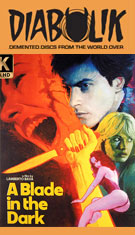
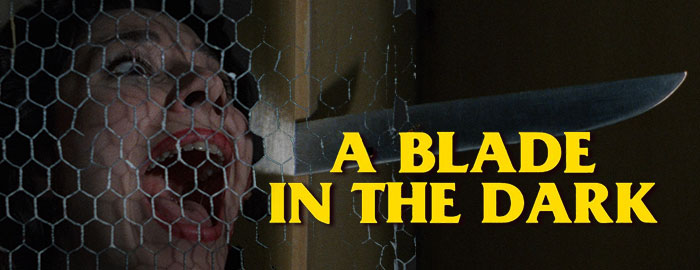
Color, 1982, 108 mins. 56 secs. /
Directed by Lamberto Bava
Starring Andrea Occhipinti, Lara Naszinsky, Anny Papa, Michele Soavi, Stanko Molnar, Fabiola Toledo
Vinegar Syndrome (UHD & Blu-ray) (US R0 4K/HD), 88 Films (UHD & Blu-ray) (UK R0/RB 4K/HD) / WS (1.66:1) (16:9)
, Blue Underground / Anchor Bay (DVD) (US R0 NTSC) / WS (1.78:1) (16:9)
One of the more violent and 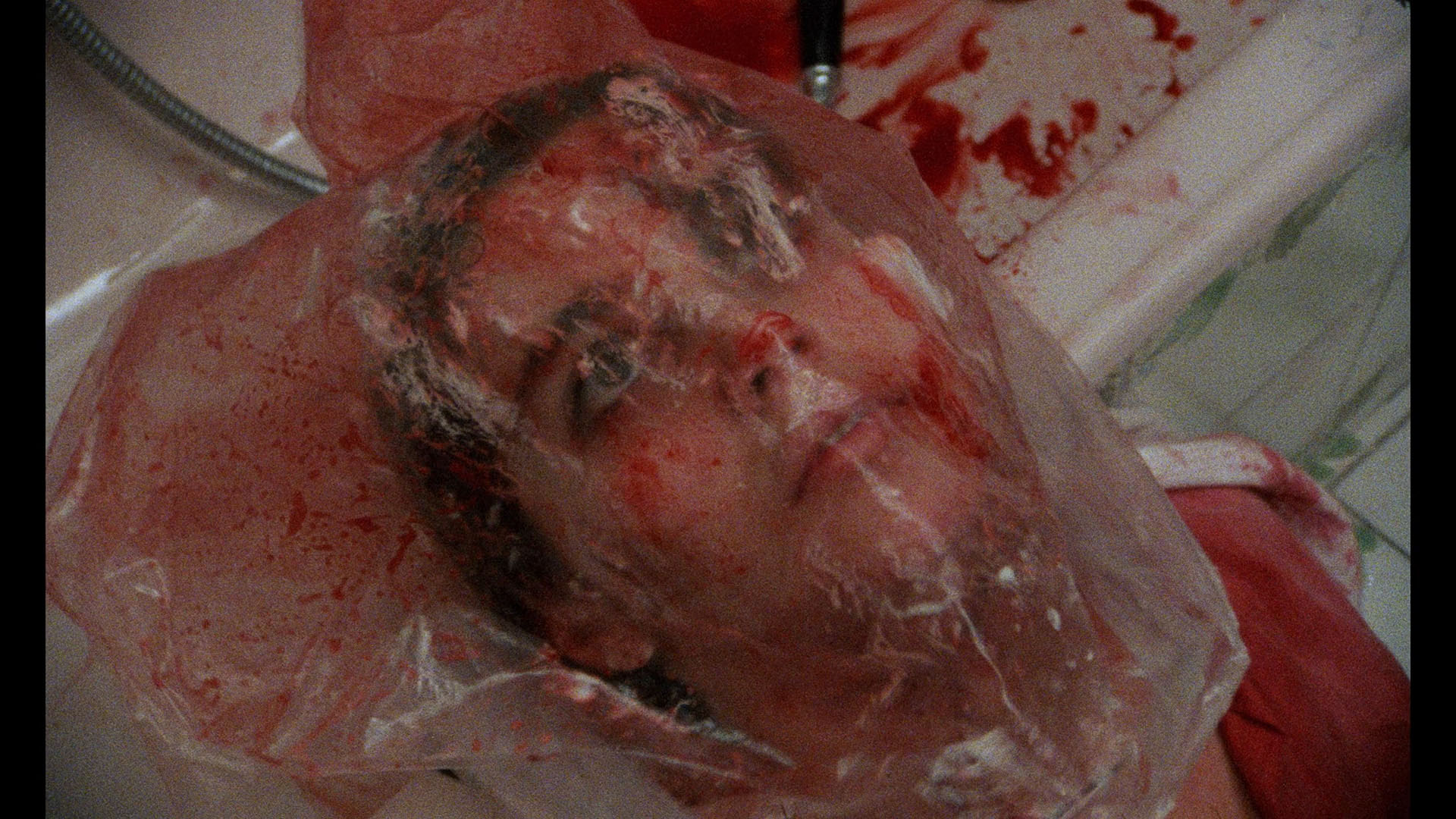 stylish entries in the Italian slasher cycle of the early '80s, A Blade in the Dark attempts to
stylish entries in the Italian slasher cycle of the early '80s, A Blade in the Dark attempts to 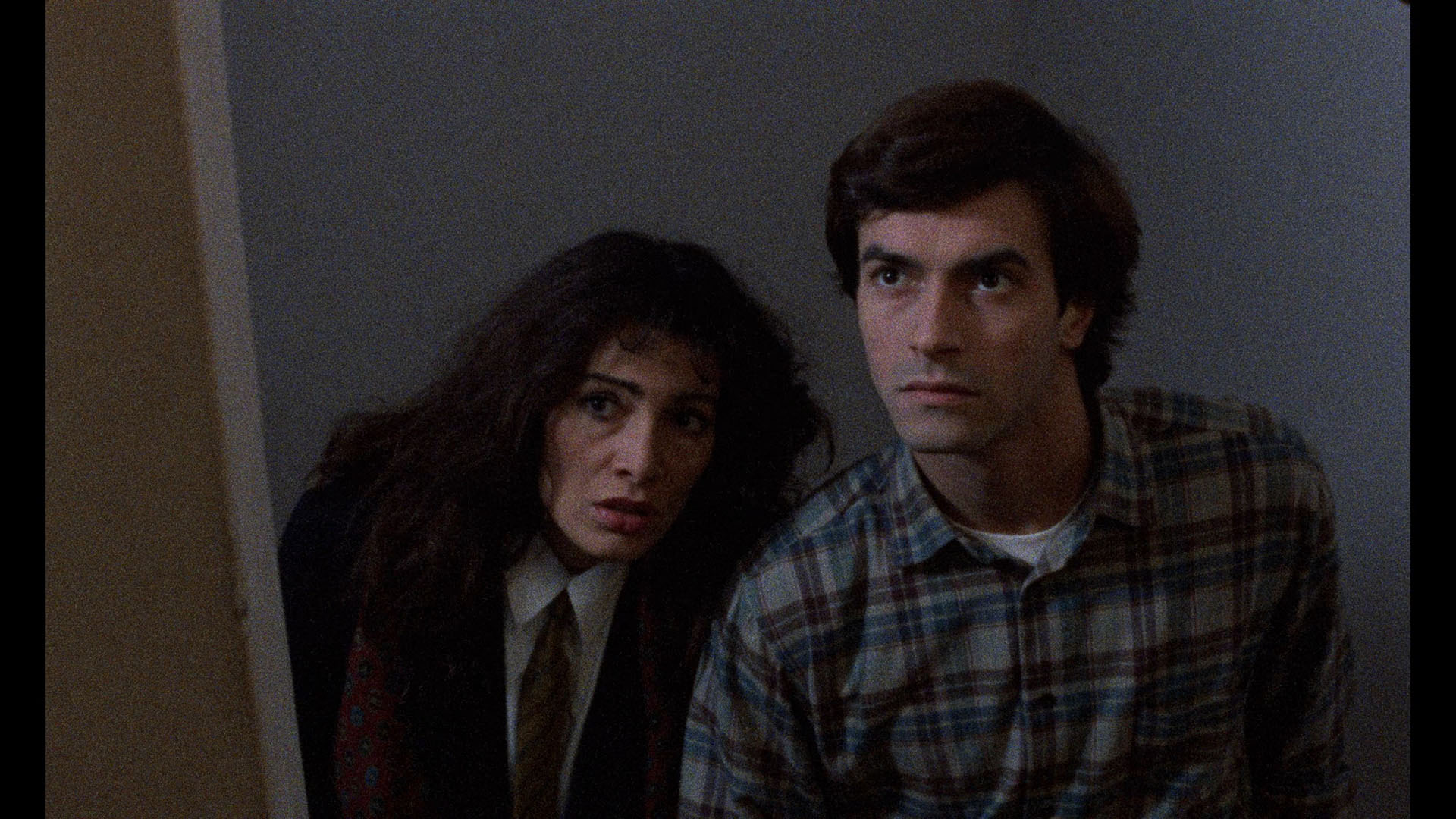 outdo Dario Argento's Tenebrae with a similar stalk-and-slash mode that eventually escalates into a bloodbath that wipes out most of the cast. Son of legendary director Mario, Lamberto Bava's experience behind the camera as assistant director for both his father and for Argento shines through here; amazingly, Blade was only his second film following his promising debut, Macabre (Frozen Terror), and here he cultivates his skills for dealing with irrational fantasy and gore which erupted full force in the later Demons films.
outdo Dario Argento's Tenebrae with a similar stalk-and-slash mode that eventually escalates into a bloodbath that wipes out most of the cast. Son of legendary director Mario, Lamberto Bava's experience behind the camera as assistant director for both his father and for Argento shines through here; amazingly, Blade was only his second film following his promising debut, Macabre (Frozen Terror), and here he cultivates his skills for dealing with irrational fantasy and gore which erupted full force in the later Demons films.
Young composer Bruno (Occhipinti) is hired by his director friend Sandra (Papa) to score her latest horror film. To get him into the mood, she sends him to stay at a rented villa which whose spooky atmosphere will hopefully inspire him to write a truly terrifying score. They both get more than they bargained for, however, when a killer starts stalking the grounds. On his first night, Bruno is startled by a ditsy young woman named Katia (shades of Black Sunday!) hiding in the cupboard; the girl dashes off and is quickly slashed to death by an assailant wielding a utility knife. Soon after, another girl who drops by to use the pool winds up disappearing as well. As the suspects begin to add up, even including Bruno's actress girlfriend, Julia (Naszinsky), he begins to put together the pieces of the puzzle and comes to realize that there's more than a passing connection between the film he's scoring and the rising body count in real life.
The true running time for A Blade in the Dark (original title: La casa con la scala nel buio, or House of the Dark Stairway) has long been a matter of confusion. The film was originally shot for Italian television (hard to believe considering the extreme gore on display) and planned as 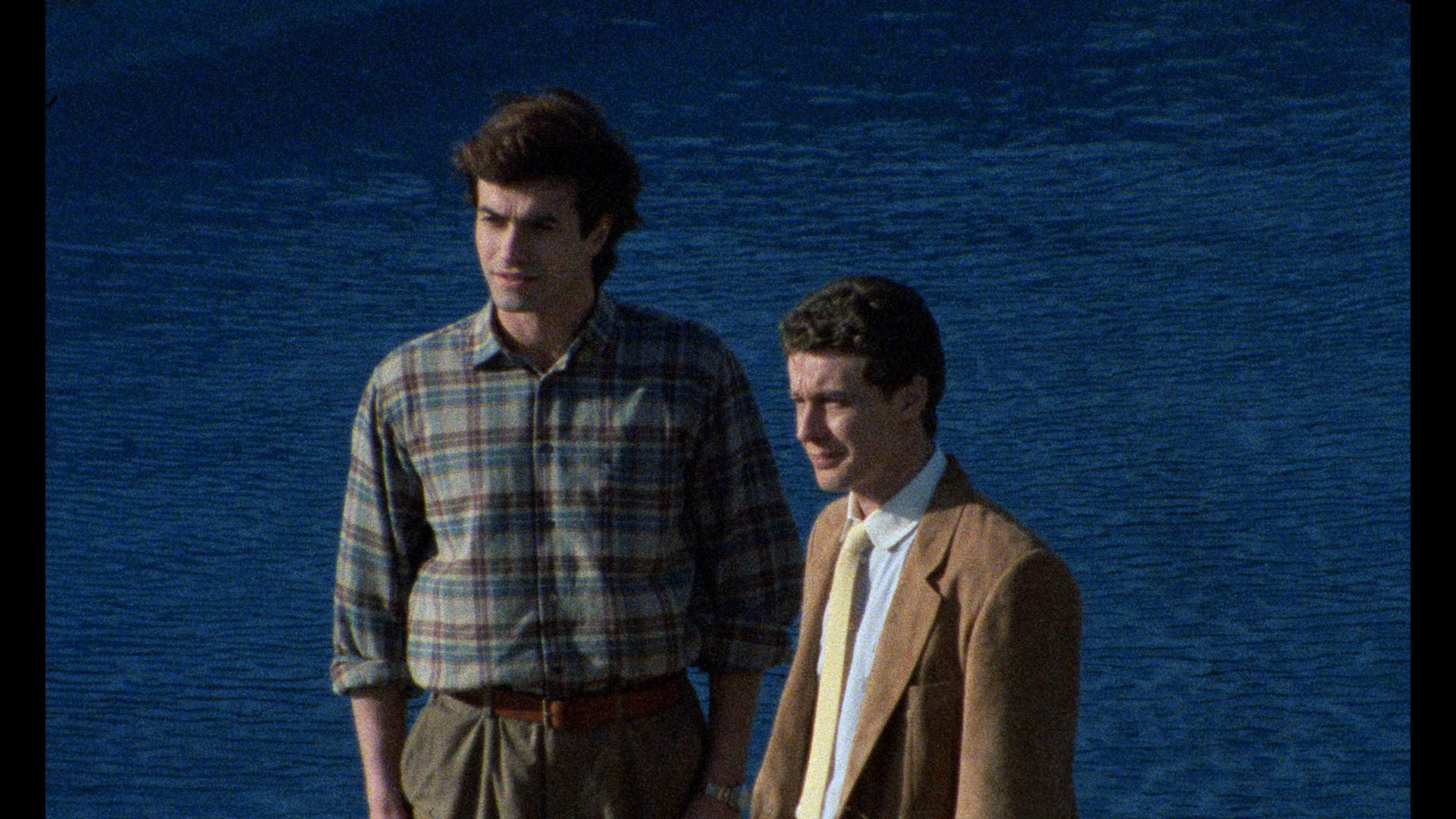 four 27-minute installments. However, the final
four 27-minute installments. However, the final 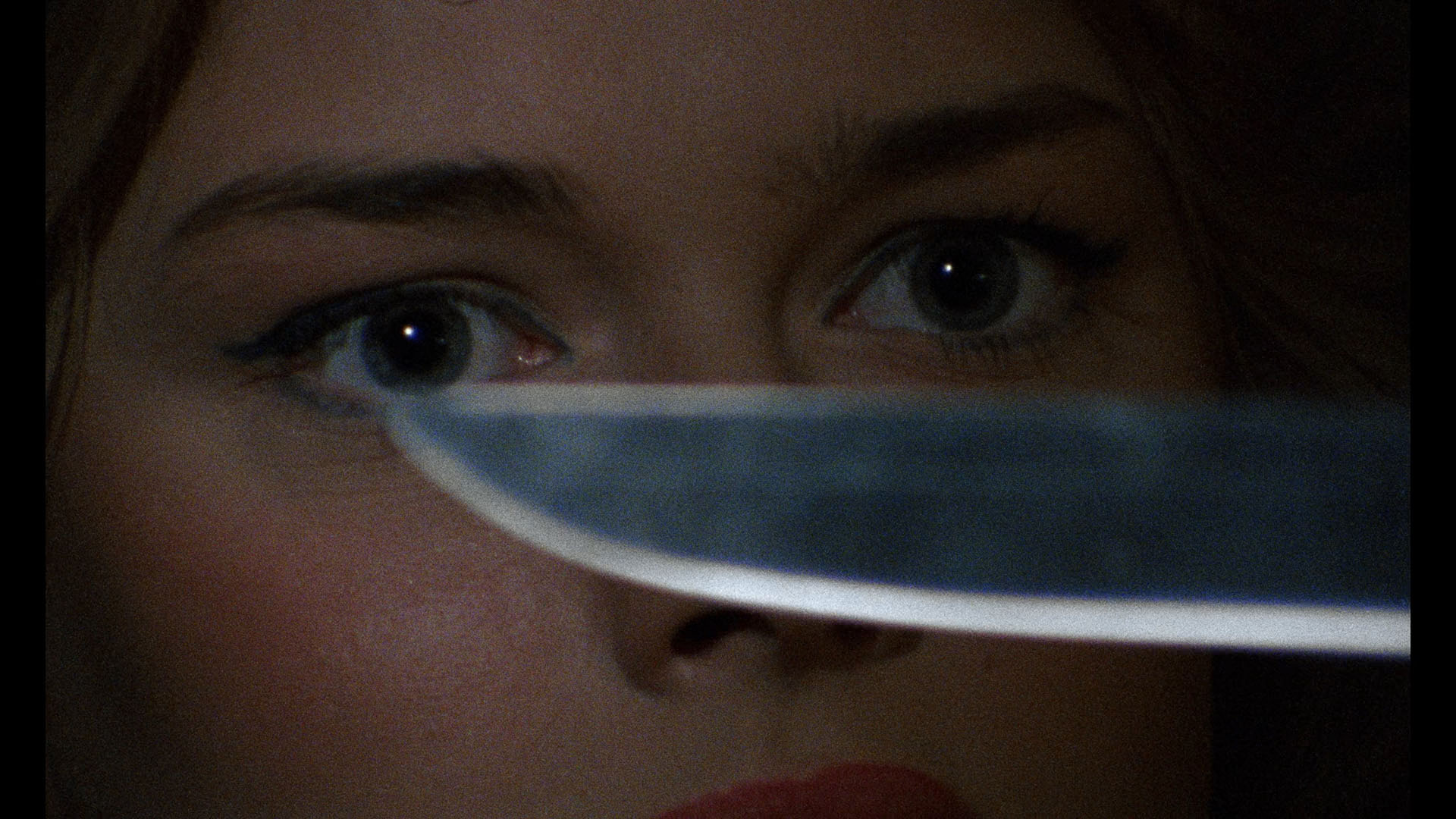 cut of the film slated for theatrical release, at least in its English language form, wound up at 96 minutes, the only authorized cut overseen by Bava himself. The version seen on laserdisc from EC Entertainment and earlier on VHS by Lightning Video in the '80s was this final director's cut for international distribution; however, a longer version existed only in Italian for years and floated through some bootleg tape dealers. The first English-language longer version turned up on DVD from Anchor Bay in the early '00s, claiming 104 minutes on the packing but running 108m36s. The extra footage adds nothing in the way of plot development or gore; some of the restored scenes include Bruno making a pay booth call to Julia's boss, more night scenes of Bruno exploring the house, a longer build up to the second murder, and several extra red herring bits involving Stanko Molnar as the groundsman, fondling scissors and generally acting suspiciously. This material slows the pace down considerably, and fan opinions about the film became much more mixed after the Anchor Bay disc was released. Despite the 16mm origins, Blade looked surprisingly good on DVD for the time, some inherent graininess in the original negative notwithstanding. The film itself has held up fairly well, thanks mainly to the shocking murder scenes (though the last killing is questionable!) and an appealing lead performance by Occhipinti, who also appeared in Lucio Fulci's New York Ripper and Conquest before achieving infamy as the bullfighter who slurps honey off of Bo Derek in Bolero. Future horror director Michele Soavi makes a very amusing appearance here and even served as first unit director (hopefully out of costume at the time). The rest of the cast is somewhat less impressive, though this may be due to the ridiculous dubbing ("I love composers; so tell me, how are you in the feathers?" and "Is it possible you're a vacant nerd?" are two of the most oft-quoted offenders). As always, the De Angelis brothers deliver a top notch score, basically a repetitious electronic tune a la Halloween that weaves in and out of Bruno's keyboard performances and
cut of the film slated for theatrical release, at least in its English language form, wound up at 96 minutes, the only authorized cut overseen by Bava himself. The version seen on laserdisc from EC Entertainment and earlier on VHS by Lightning Video in the '80s was this final director's cut for international distribution; however, a longer version existed only in Italian for years and floated through some bootleg tape dealers. The first English-language longer version turned up on DVD from Anchor Bay in the early '00s, claiming 104 minutes on the packing but running 108m36s. The extra footage adds nothing in the way of plot development or gore; some of the restored scenes include Bruno making a pay booth call to Julia's boss, more night scenes of Bruno exploring the house, a longer build up to the second murder, and several extra red herring bits involving Stanko Molnar as the groundsman, fondling scissors and generally acting suspiciously. This material slows the pace down considerably, and fan opinions about the film became much more mixed after the Anchor Bay disc was released. Despite the 16mm origins, Blade looked surprisingly good on DVD for the time, some inherent graininess in the original negative notwithstanding. The film itself has held up fairly well, thanks mainly to the shocking murder scenes (though the last killing is questionable!) and an appealing lead performance by Occhipinti, who also appeared in Lucio Fulci's New York Ripper and Conquest before achieving infamy as the bullfighter who slurps honey off of Bo Derek in Bolero. Future horror director Michele Soavi makes a very amusing appearance here and even served as first unit director (hopefully out of costume at the time). The rest of the cast is somewhat less impressive, though this may be due to the ridiculous dubbing ("I love composers; so tell me, how are you in the feathers?" and "Is it possible you're a vacant nerd?" are two of the most oft-quoted offenders). As always, the De Angelis brothers deliver a top notch score, basically a repetitious electronic tune a la Halloween that weaves in and out of Bruno's keyboard performances and 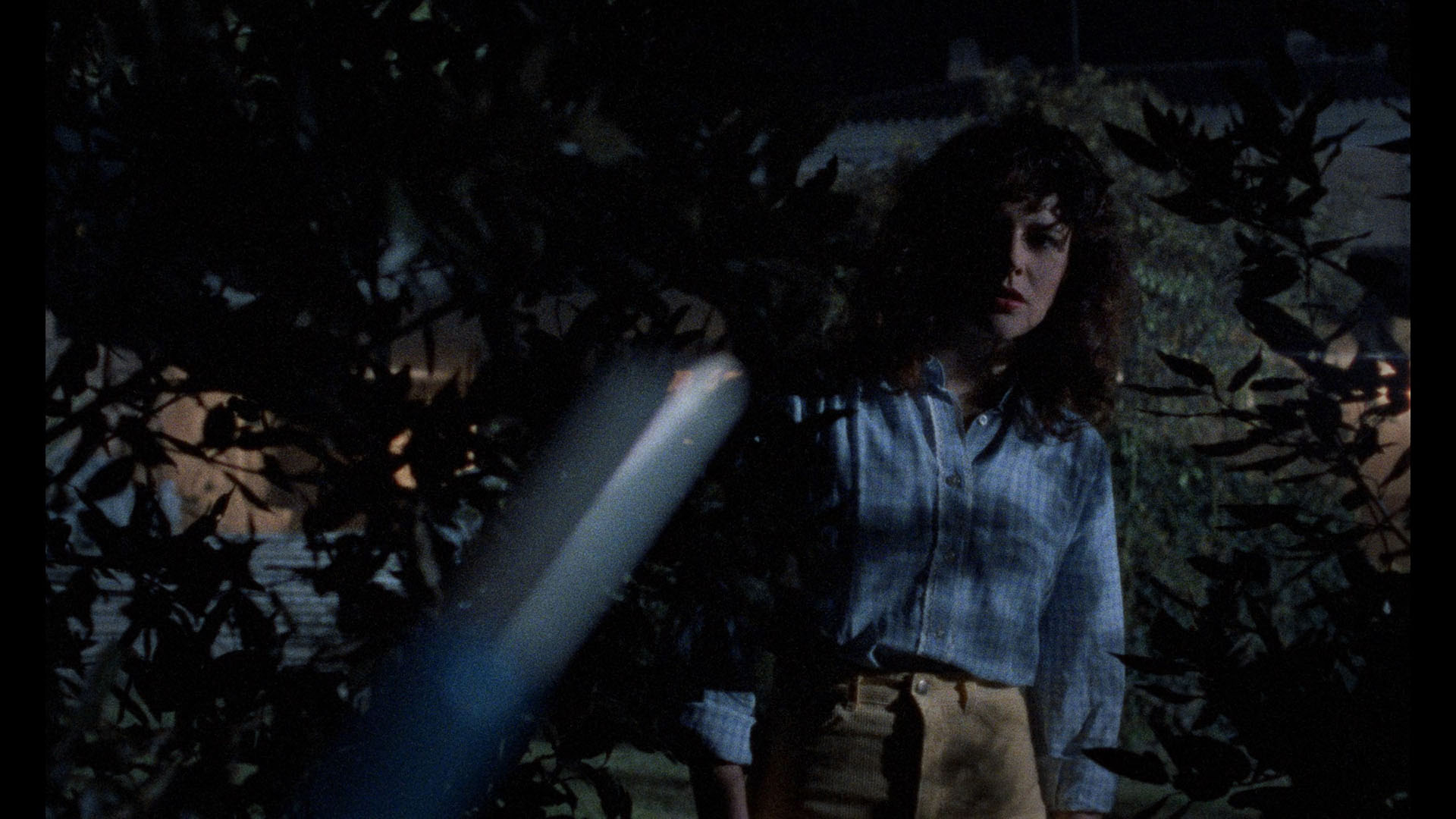 the murders themselves. Extras include a "Behind the Blade"
the murders themselves. Extras include a "Behind the Blade" 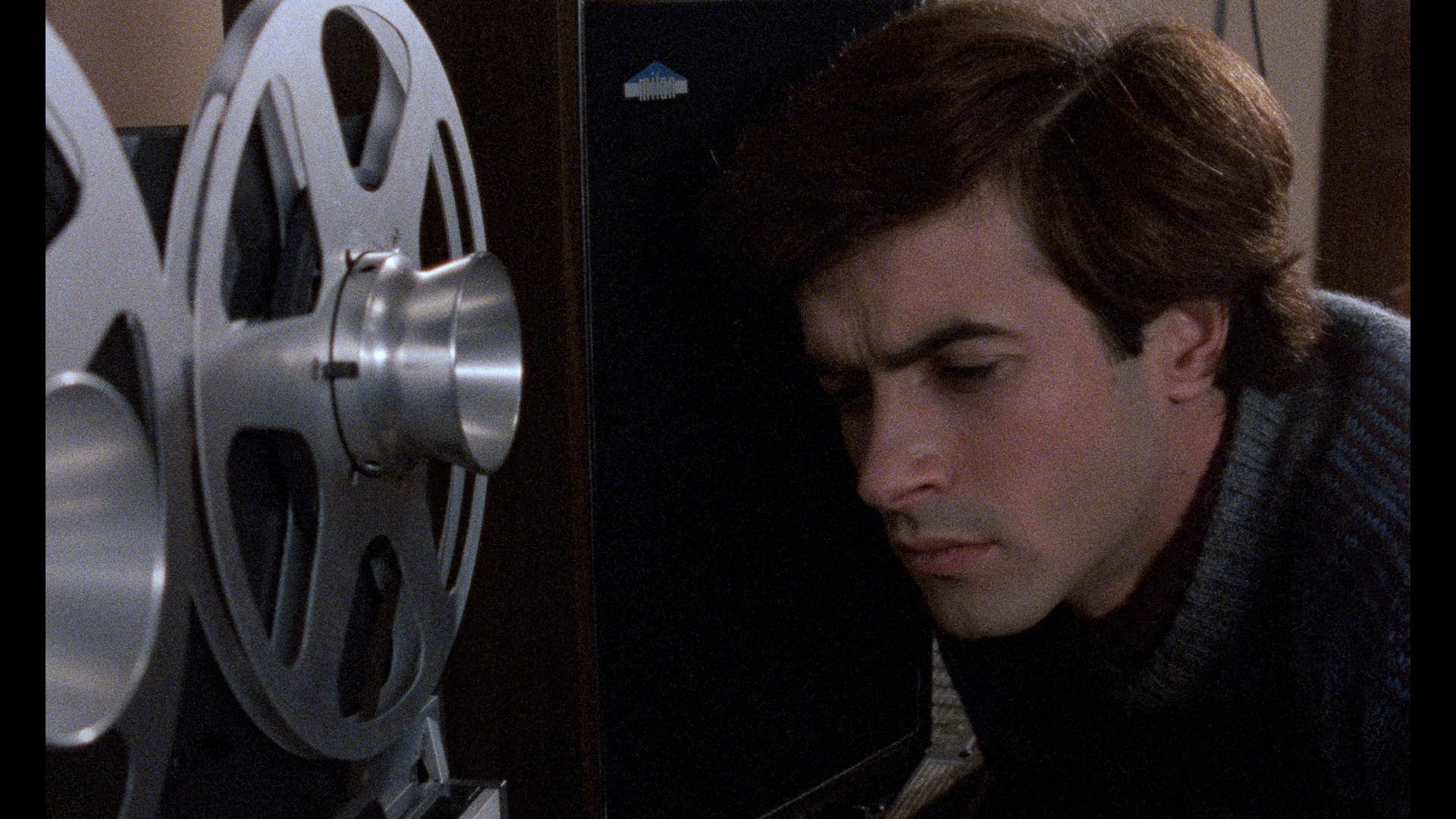 interview (9m27s) with Lamberto Bava and writer Dardano Sacchetti in which they discuss the genesis of the film and the low budget shooting process, some appreciative liner notes by Tim Lucas, and the gory European theatrical trailer. The same disc was later reissued with an identical transfer and extras from Blue Underground.
interview (9m27s) with Lamberto Bava and writer Dardano Sacchetti in which they discuss the genesis of the film and the low budget shooting process, some appreciative liner notes by Tim Lucas, and the gory European theatrical trailer. The same disc was later reissued with an identical transfer and extras from Blue Underground.
In 2015, U.K. label 88 Films added the film to its early roster of Blu-ray Italian horror releases alongside such titles as Anthropophagus and The Night Train Murders. The 16mm origins are still in evidence here but overall it's satisfying on the more modest end of the scale, vaulting way past the DVD in terms of clarity and preserving the more vertically spacious 1.66:1 aspect ratio compared to the slightly windowboxed 1.78: 1 version on the DVD. The extra room on the top and bottom helps quite a bit, restoring balance to compositions that previously bordered on the claustrophobic. Interestingly, it also sports a completely different opening credits sequence featuring a freeze frame of the bloody tennis ball instead of the black background in past transfers. (This tennis ball opening is also seen in the Italian version.) This discrepancy may also account for the fact that this runs a minute shorter than the American DVD, as it otherwise appears to contain the added material from the Italian extended version. However, in addition to a more robust LPCM rendering of the English dub track, the biggest plus here is the inclusion (at last) of the original Italian audio with English subtitles which can be switched on or off via which option you choose from the menu. The actors were all speaking Italian for the production, and the translation here is far more natural and classy with all of that illogical, wince-inducing dialogue making quite a bit more sense. (For example, the awkward "Female, you're a female" at the beginning is now "Little girl.")
Extras on this edition include the Italian-language opening and closing credits, a 19-minute interview with cinematographer Gianlorenzo Battaglia (who also served under Mario for many years and talks about his Lamberto collaborations in some depth including shooting this film on the property of producer  Luciano Martino in a scant 18 days), and a 50-minute screening Q&A with Bava moderated by an uncredited Calum Waddell staring with his early assistant directing days (including Bay of Blood) through his more famous directorial efforts. The camcorder lensing and Bava's thick accent are a little challenging, but there's
Luciano Martino in a scant 18 days), and a 50-minute screening Q&A with Bava moderated by an uncredited Calum Waddell staring with his early assistant directing days (including Bay of Blood) through his more famous directorial efforts. The camcorder lensing and Bava's thick accent are a little challenging, but there's 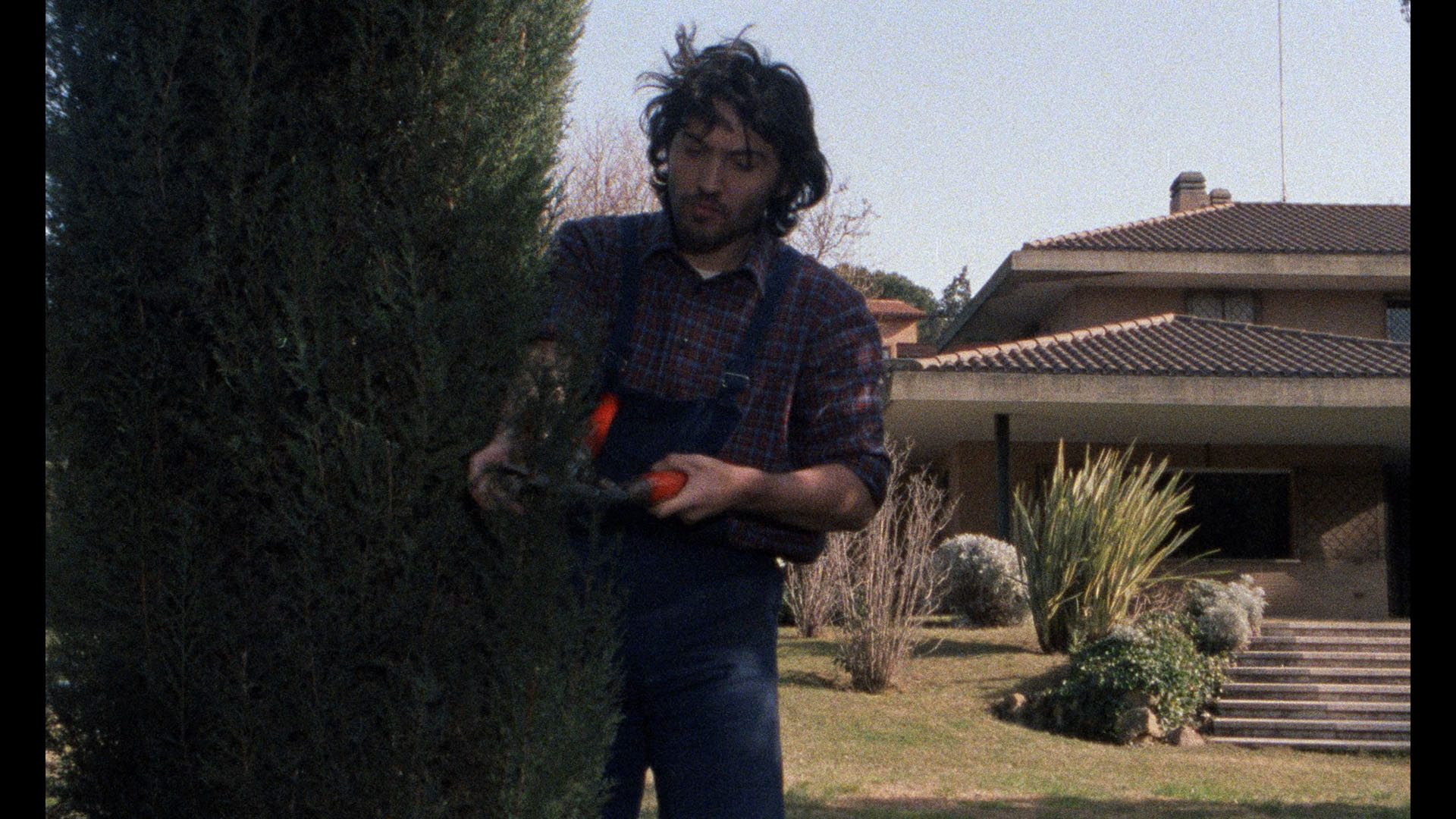 some good material here reminiscing about Italian horror's golden age.
some good material here reminiscing about Italian horror's golden age.
In 2023, Vinegar Syndrome bowed the film on UHD for the first time with Blu-rays to match in a four-disc(!) set featuring a radically improved 4K scan from the original camera negative. One UHD and one Blu-ray each are devoted to each cut of the film, a welcome gesture; if this is your first time viewing the film, absolutely go for the theatrical cut first. Both versions feature DTS-HD MA 2.0 English and Italian tracks, both sounding excellent, with optional English SDH or English-translated subtitles (plus narrative subtitles only for on-screen text). A disclaimer at the beginning notes the reason for the reduced running time of the previous HD transfer which had "inexplicably removed several frames from each shot," causing those missing two minutes. Both the UHD and Blu-ray of the extended cut feature two new audio commentary tracks; the first features the foursome from The Hysteria Continues who talk about this and Bava's other gialli like Delirium and Body Puzzle, the state of the giallo in the '80s after Argento and Fulci had pushed it into savage new territory, the depiction of the killer that ties into a certain De Palma film and might ruffle feathers today, the striking art for the VHS release in the '80s, the more amusing quirks of the dialogue and Bruno's time-killing activities, and the reception of the hyper-violent content in this film's biggest kill scenes. In the second audio commentary, Kat Ellinger enthuses about the effective prologue, the film's place within the larger framework of Bava's body of work, the elements of gender upheaval running throughout the story including its depiction of a female Italian director, the tropes of '80s Euro horror before its commercial prospects died out, the 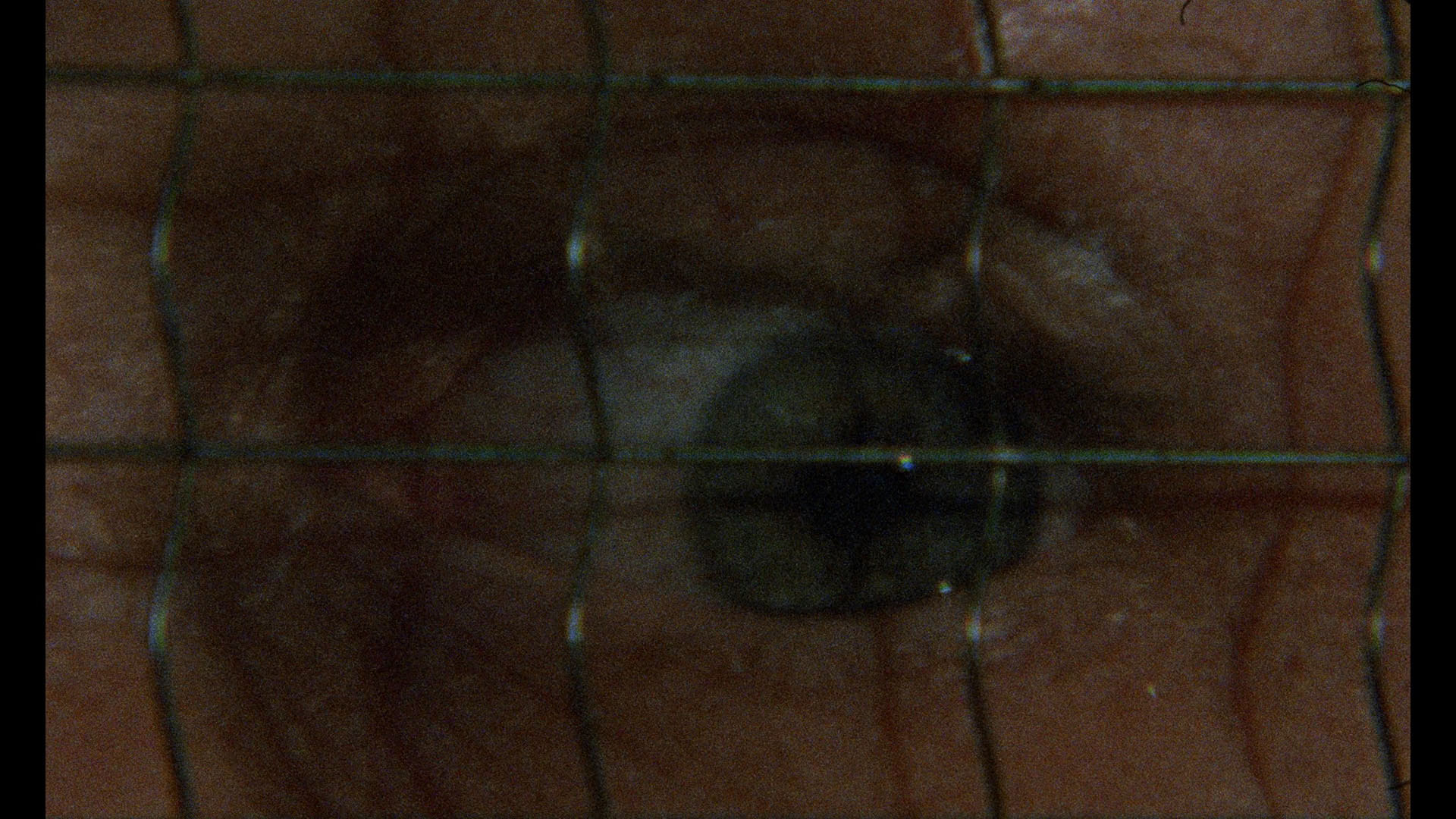 waning days of grindhouse theaters, and
waning days of grindhouse theaters, and 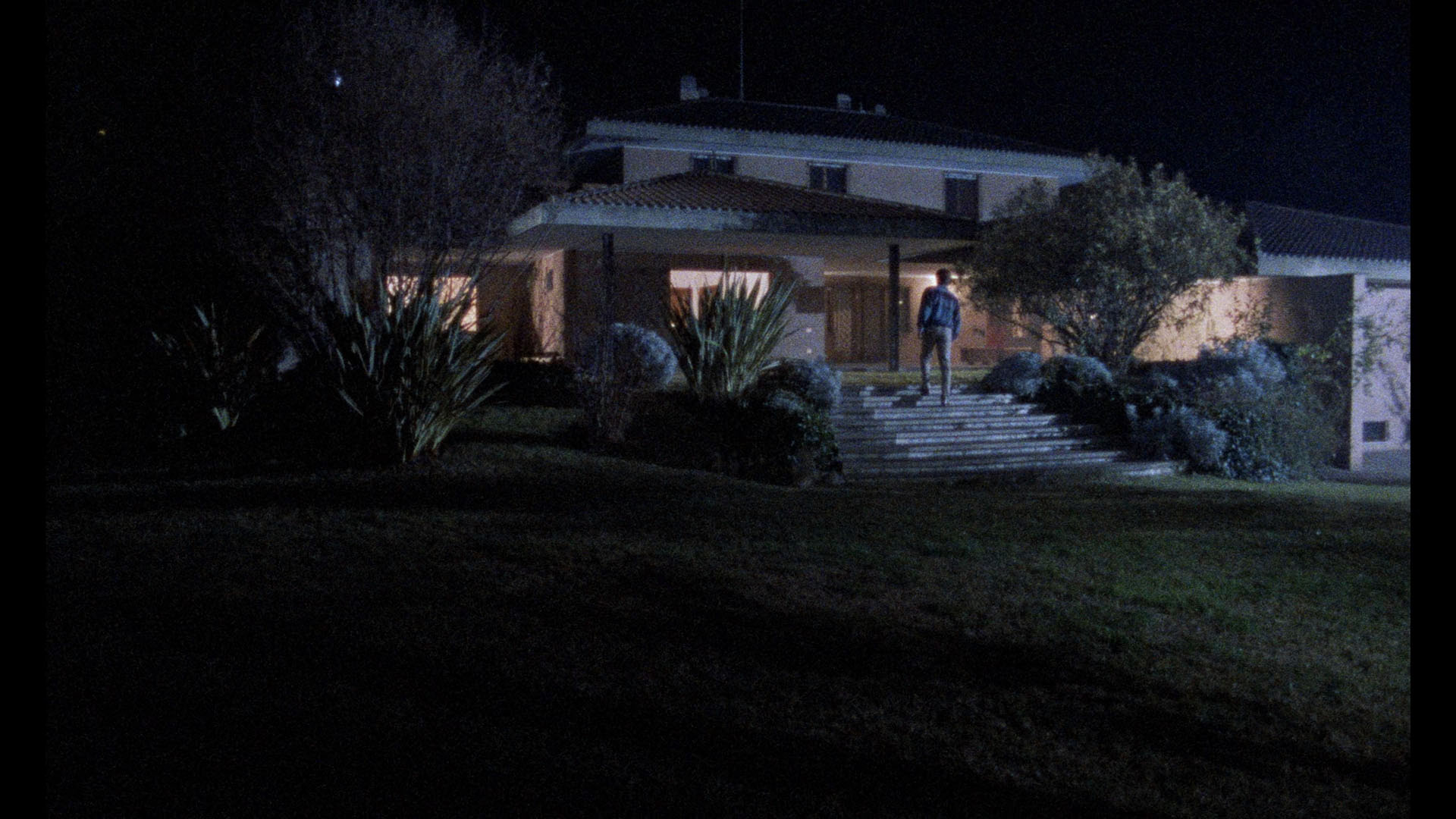 nods to other directors like Argento and Hitchcock.
nods to other directors like Argento and Hitchcock.
"Don't Go Down the Stairs" (16m34s) is a new video interview with Lamberto Bava covering Luciano Martino's formidable status as a producer, an aborted project before this that went to Fulci, the edict to have a killing in this one every 20 minutes, the budgetary constraints of the production, and casting Soavi in his young actor days. In "House" (20m54s), screenwriter Dardano Sacchetti talks about the origins at Dania Film (subtitled as "Dagna" here for some reason), the pivotal villa location that drove much of the story, other ideas he played around with, and the financial risks (or lack thereof) making genre films around that time. "Lights in an Empty House" (16m41s) features cinematographer Gianlorenzo Battaglia looking at the very busy state of Italian cinema around '83, his path to becoming a director of photography, his working relationship with Bava and positive impressions of Soavi, and his methods for creating visual atmosphere lighting up the villa from top to bottom. Finally Samm Deighan studies "The Gothic Slashers of Lamberto Bava" (17m25s) from Bava's birth to genre cinema royalty through his work under Mario on numerous films and finally his auspicious debut with Macabre and cross-pollination of slashers, gialli, and supernatural elements from that point onward. Also included on that disc are the Italian and English trailers. The other Blu-ray featuring the theatrical cut also ports over the "Behind the Blade" featurette from the Anchor Bay disc and also adds All the Colors of Giallo (89m1s), Federico Caddeo's documentary also available as part of a three-disc set from Severin Films from 2019. The very stylish and impressive packaging also comes with a 40-page book featuring new essays by Caroline Kopko, Alexandra Heller-Nicholas, and Dana Reinoos.
VINEGAR SYNDROME (Blu-ray)
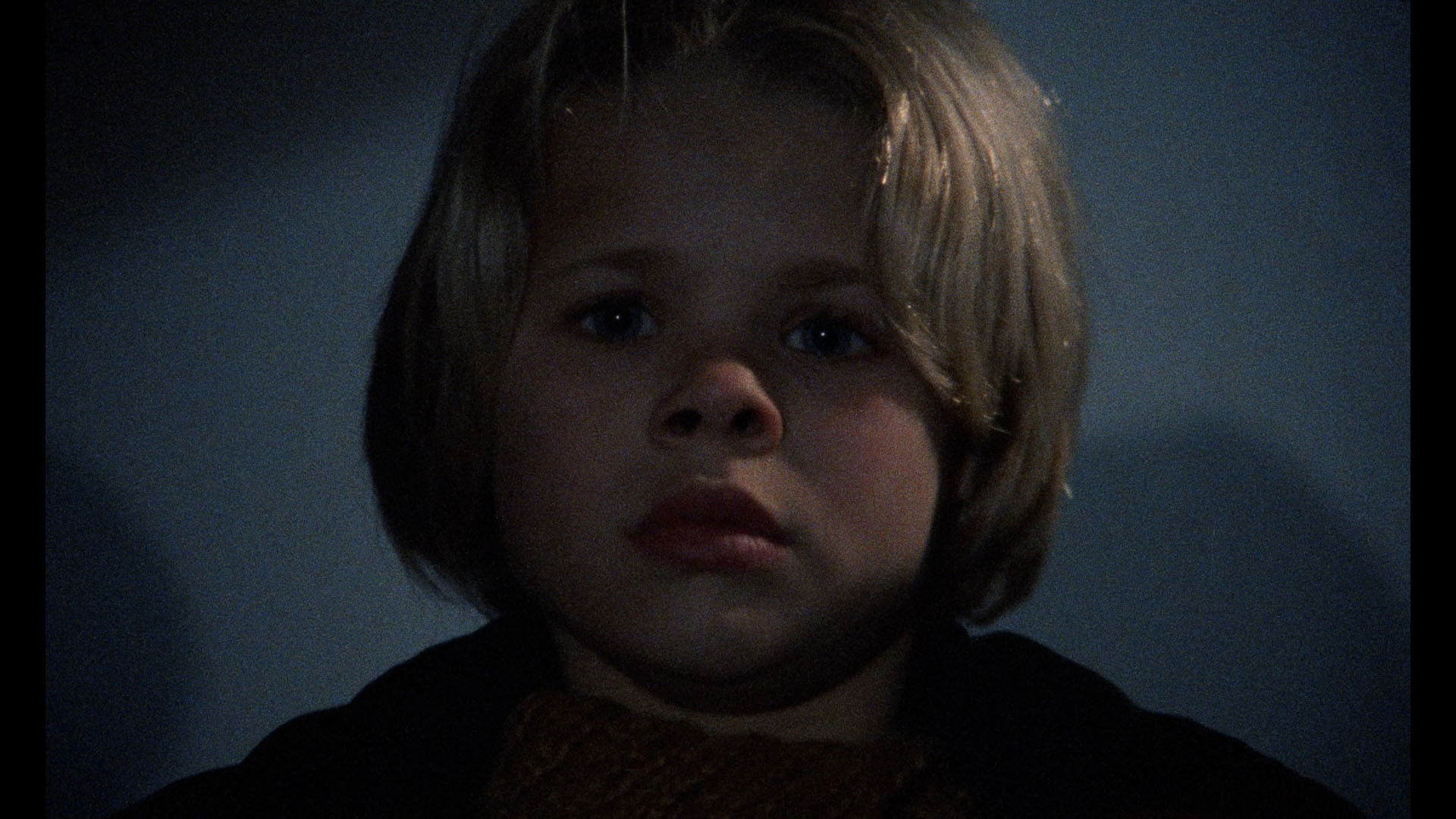
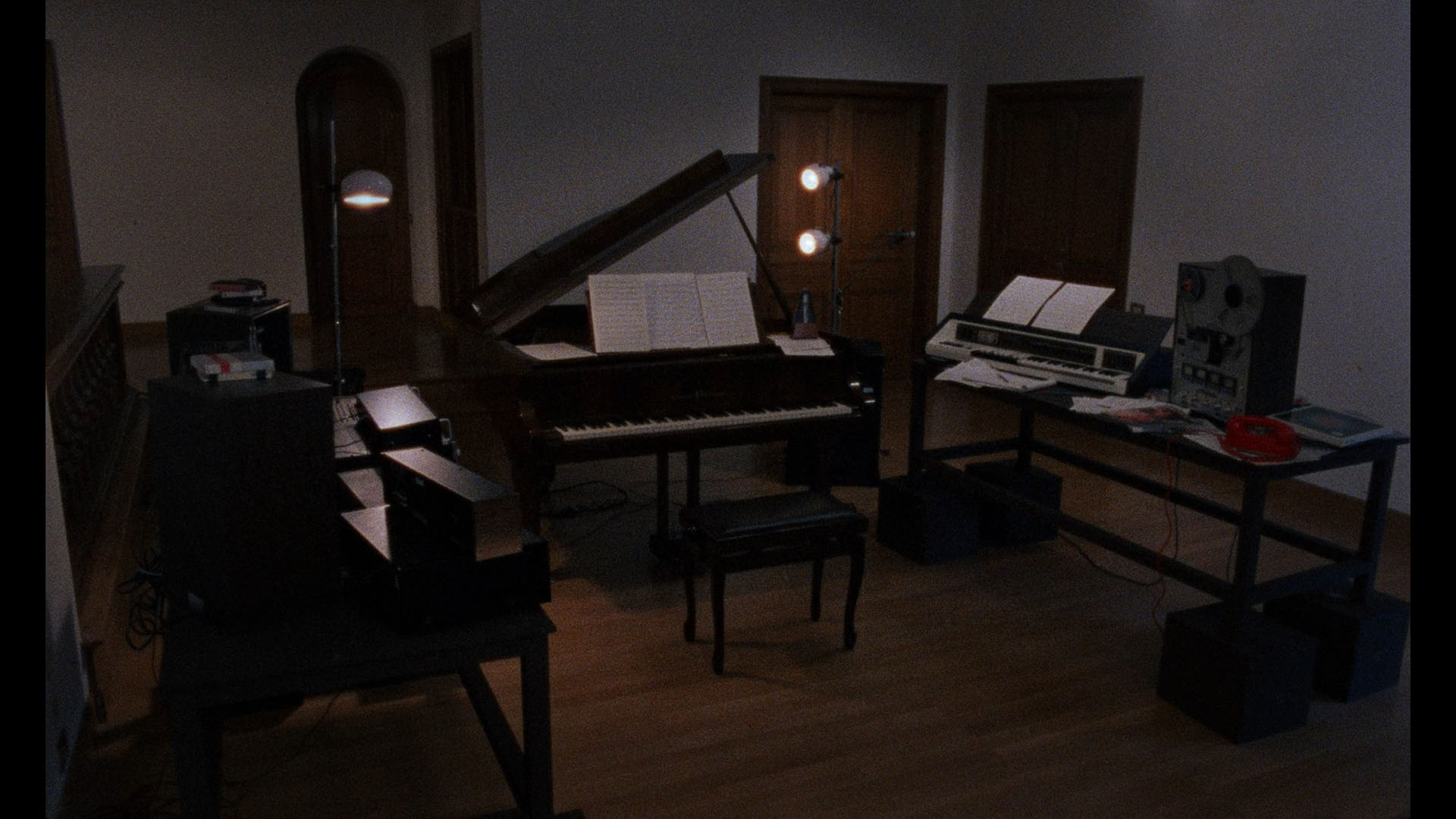


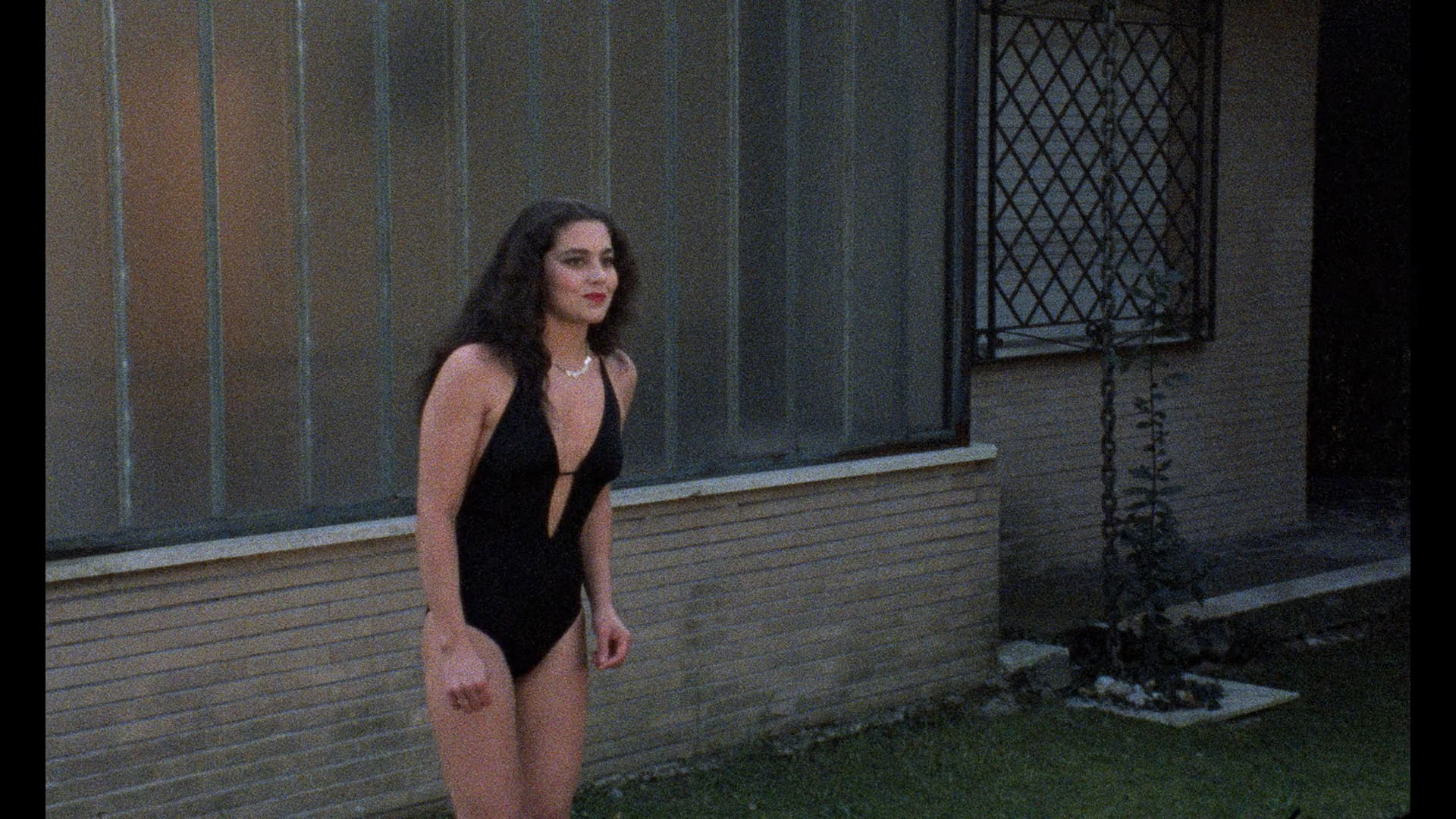
88 FILMS (Blu-ray)
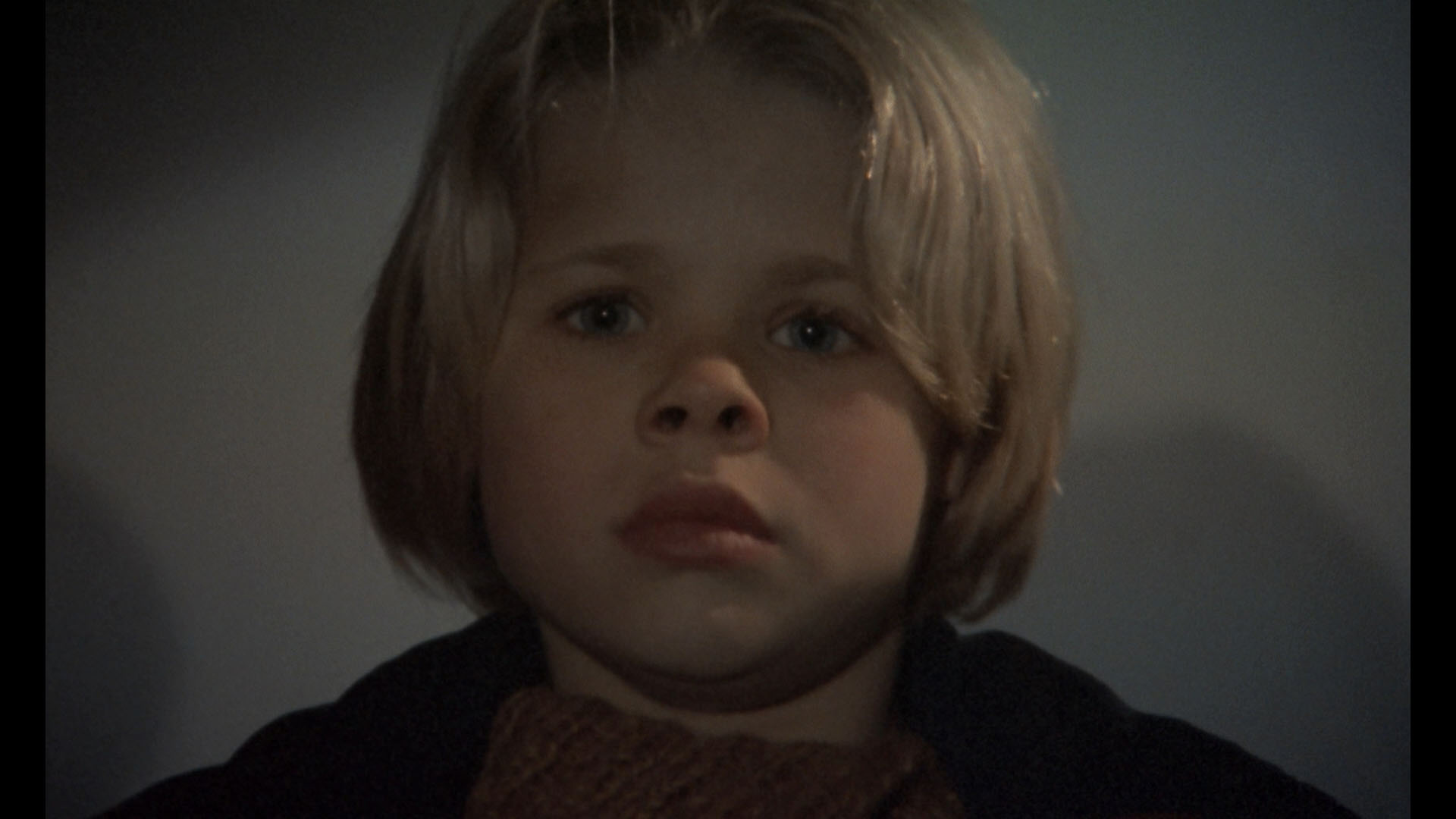
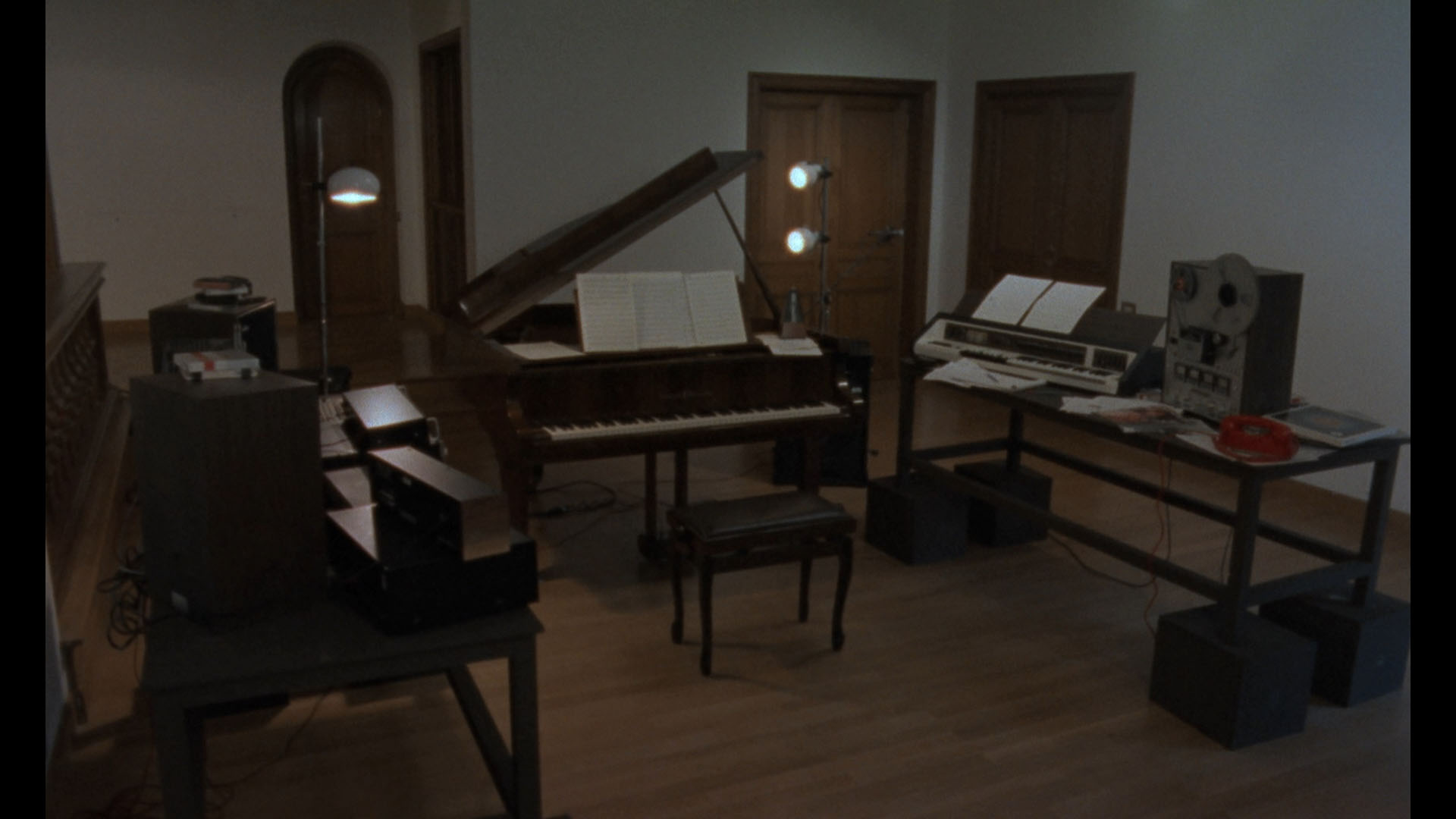
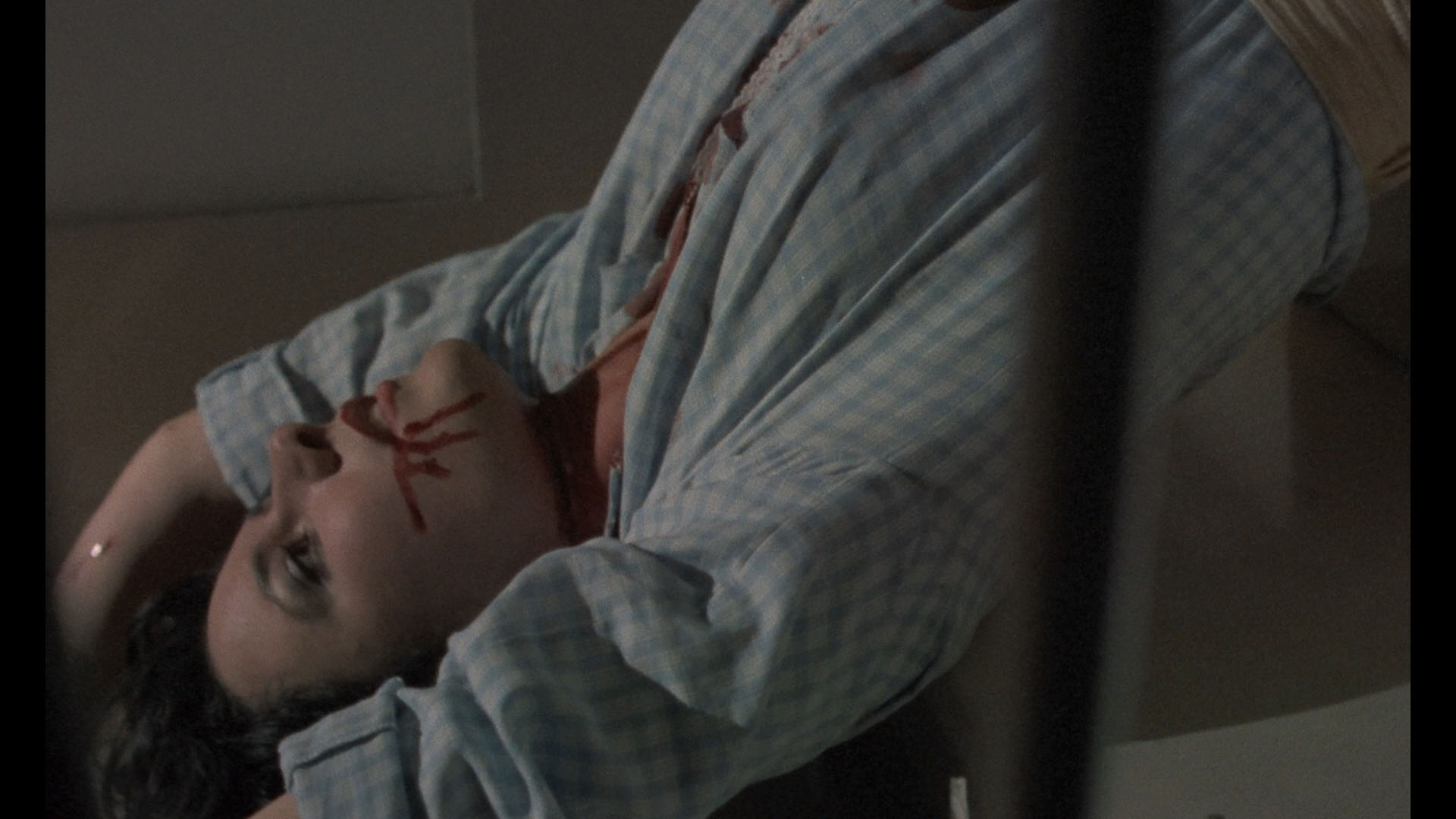
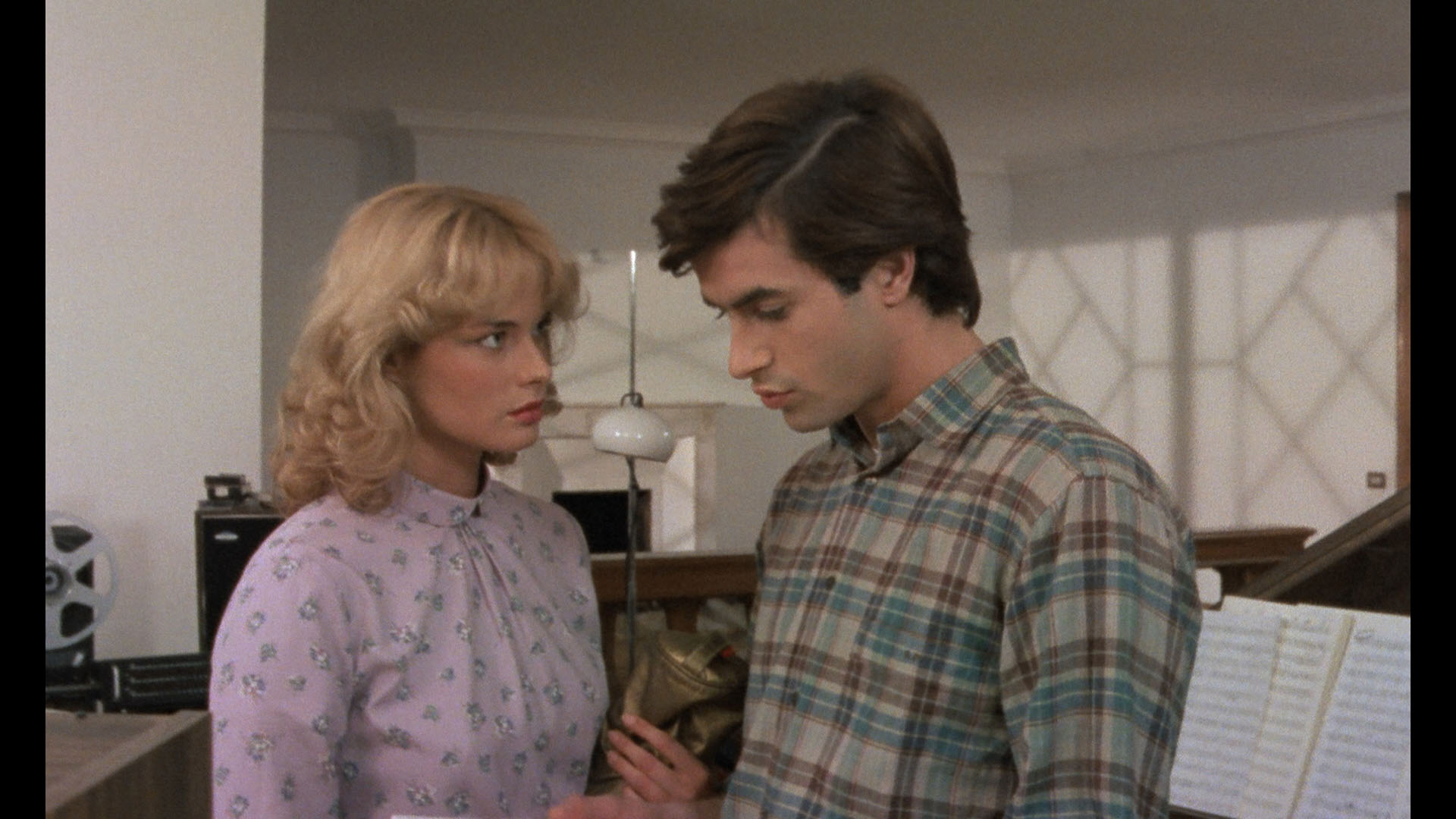
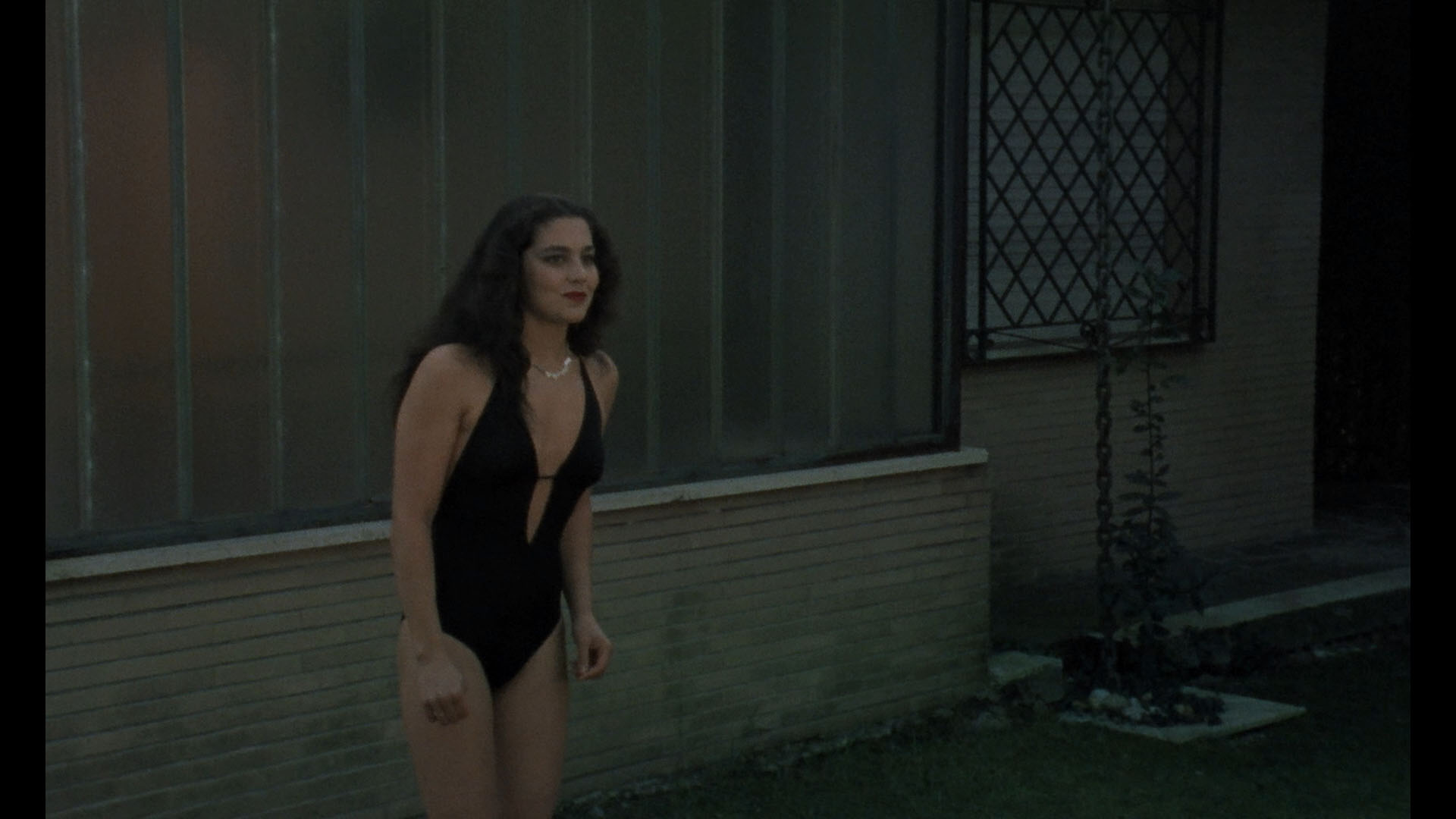
ANCHOR BAY (DVD)
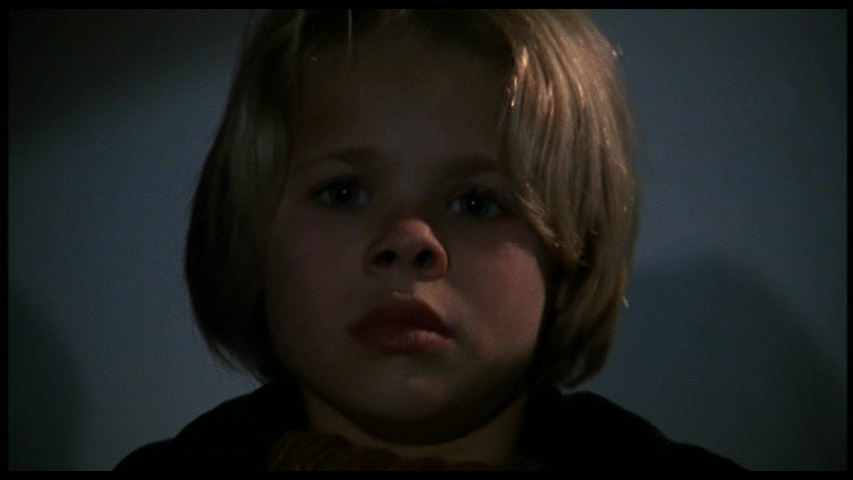
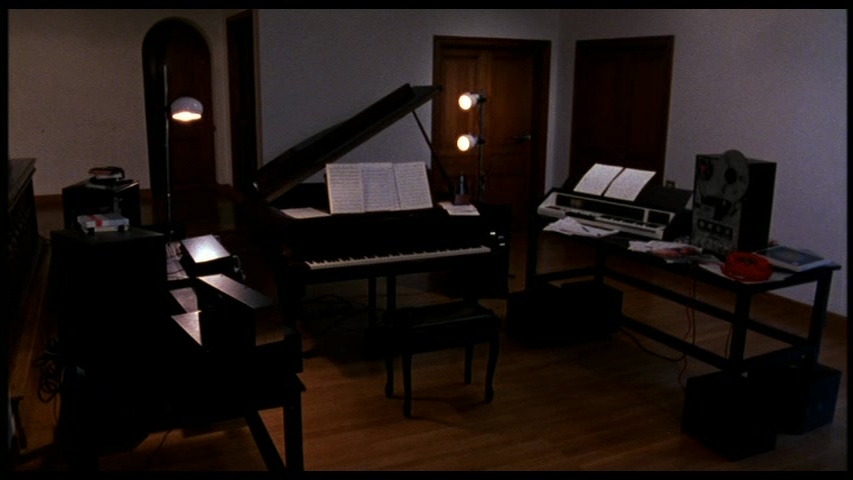
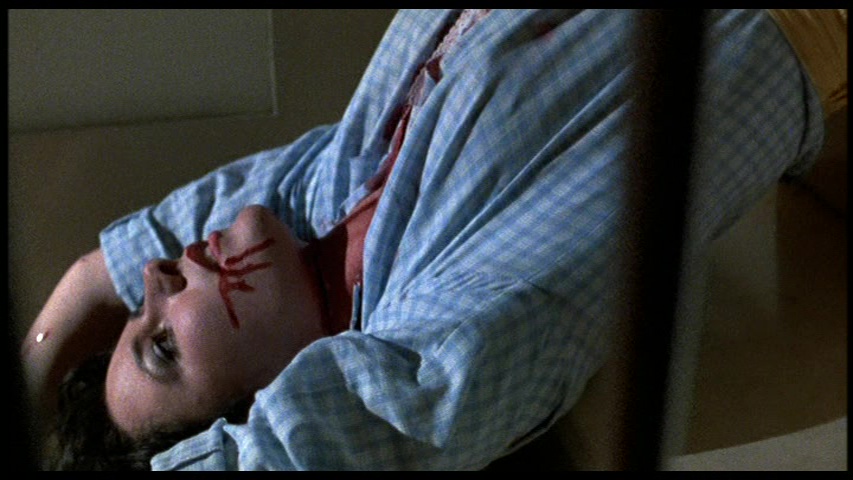

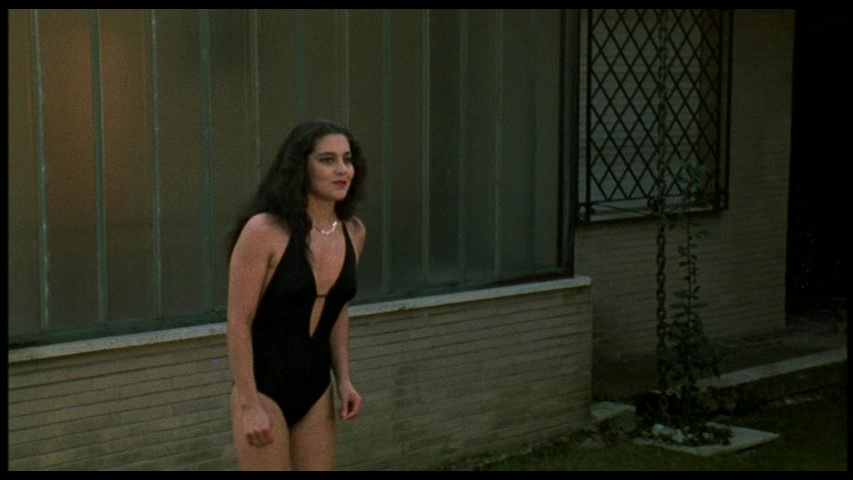
Updated review on July 28, 2023





 stylish entries in the Italian slasher cycle of the early '80s, A Blade in the Dark attempts to
stylish entries in the Italian slasher cycle of the early '80s, A Blade in the Dark attempts to  outdo Dario Argento's Tenebrae with a similar stalk-and-slash mode that eventually escalates into a bloodbath that wipes out most of the cast. Son of legendary director Mario, Lamberto Bava's experience behind the camera as assistant director for both his father and for Argento shines through here; amazingly, Blade was only his second film following his promising debut, Macabre (Frozen Terror), and here he cultivates his skills for dealing with irrational fantasy and gore which erupted full force in the later Demons films.
outdo Dario Argento's Tenebrae with a similar stalk-and-slash mode that eventually escalates into a bloodbath that wipes out most of the cast. Son of legendary director Mario, Lamberto Bava's experience behind the camera as assistant director for both his father and for Argento shines through here; amazingly, Blade was only his second film following his promising debut, Macabre (Frozen Terror), and here he cultivates his skills for dealing with irrational fantasy and gore which erupted full force in the later Demons films.  four 27-minute installments. However, the final
four 27-minute installments. However, the final  cut of the film slated for theatrical release, at least in its English language form, wound up at 96 minutes, the only authorized cut overseen by Bava himself. The version seen on laserdisc from EC Entertainment and earlier on VHS by Lightning Video in the '80s was this final director's cut for international distribution; however, a longer version existed only in Italian for years and floated through some bootleg tape dealers. The first English-language longer version turned up on DVD from Anchor Bay in the early '00s, claiming 104 minutes on the packing but running 108m36s. The extra footage adds nothing in the way of plot development or gore; some of the restored scenes include Bruno making a pay booth call to Julia's boss, more night scenes of Bruno exploring the house, a longer build up to the second murder, and several extra red herring bits involving Stanko Molnar as the groundsman, fondling scissors and generally acting suspiciously. This material slows the pace down considerably, and fan opinions about the film became much more mixed after the Anchor Bay disc was released. Despite the 16mm origins, Blade looked surprisingly good on DVD for the time, some inherent graininess in the original negative notwithstanding. The film itself has held up fairly well, thanks mainly to the shocking murder scenes (though the last killing is questionable!) and an appealing lead performance by Occhipinti, who also appeared in Lucio Fulci's New York Ripper and Conquest before achieving infamy as the bullfighter who slurps honey off of Bo Derek in Bolero. Future horror director Michele Soavi makes a very amusing appearance here and even served as first unit director (hopefully out of costume at the time). The rest of the cast is somewhat less impressive, though this may be due to the ridiculous dubbing ("I love composers; so tell me, how are you in the feathers?" and "Is it possible you're a vacant nerd?" are two of the most oft-quoted offenders). As always, the De Angelis brothers deliver a top notch score, basically a repetitious electronic tune a la Halloween that weaves in and out of Bruno's keyboard performances and
cut of the film slated for theatrical release, at least in its English language form, wound up at 96 minutes, the only authorized cut overseen by Bava himself. The version seen on laserdisc from EC Entertainment and earlier on VHS by Lightning Video in the '80s was this final director's cut for international distribution; however, a longer version existed only in Italian for years and floated through some bootleg tape dealers. The first English-language longer version turned up on DVD from Anchor Bay in the early '00s, claiming 104 minutes on the packing but running 108m36s. The extra footage adds nothing in the way of plot development or gore; some of the restored scenes include Bruno making a pay booth call to Julia's boss, more night scenes of Bruno exploring the house, a longer build up to the second murder, and several extra red herring bits involving Stanko Molnar as the groundsman, fondling scissors and generally acting suspiciously. This material slows the pace down considerably, and fan opinions about the film became much more mixed after the Anchor Bay disc was released. Despite the 16mm origins, Blade looked surprisingly good on DVD for the time, some inherent graininess in the original negative notwithstanding. The film itself has held up fairly well, thanks mainly to the shocking murder scenes (though the last killing is questionable!) and an appealing lead performance by Occhipinti, who also appeared in Lucio Fulci's New York Ripper and Conquest before achieving infamy as the bullfighter who slurps honey off of Bo Derek in Bolero. Future horror director Michele Soavi makes a very amusing appearance here and even served as first unit director (hopefully out of costume at the time). The rest of the cast is somewhat less impressive, though this may be due to the ridiculous dubbing ("I love composers; so tell me, how are you in the feathers?" and "Is it possible you're a vacant nerd?" are two of the most oft-quoted offenders). As always, the De Angelis brothers deliver a top notch score, basically a repetitious electronic tune a la Halloween that weaves in and out of Bruno's keyboard performances and  the murders themselves. Extras include a "Behind the Blade"
the murders themselves. Extras include a "Behind the Blade"  interview (9m27s) with Lamberto Bava and writer Dardano Sacchetti in which they discuss the genesis of the film and the low budget shooting process, some appreciative liner notes by Tim Lucas, and the gory European theatrical trailer. The same disc was later reissued with an identical transfer and extras from Blue Underground.
interview (9m27s) with Lamberto Bava and writer Dardano Sacchetti in which they discuss the genesis of the film and the low budget shooting process, some appreciative liner notes by Tim Lucas, and the gory European theatrical trailer. The same disc was later reissued with an identical transfer and extras from Blue Underground. Luciano Martino in a scant 18 days), and a 50-minute screening Q&A with Bava moderated by an uncredited Calum Waddell staring with his early assistant directing days (including Bay of Blood) through his more famous directorial efforts. The camcorder lensing and Bava's thick accent are a little challenging, but there's
Luciano Martino in a scant 18 days), and a 50-minute screening Q&A with Bava moderated by an uncredited Calum Waddell staring with his early assistant directing days (including Bay of Blood) through his more famous directorial efforts. The camcorder lensing and Bava's thick accent are a little challenging, but there's  some good material here reminiscing about Italian horror's golden age.
some good material here reminiscing about Italian horror's golden age.  waning days of grindhouse theaters, and
waning days of grindhouse theaters, and  nods to other directors like Argento and Hitchcock.
nods to other directors like Argento and Hitchcock. 




![]()